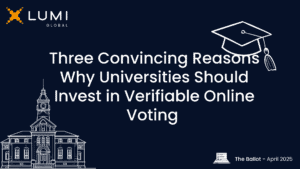This article references an older product of Assembly Voting, Assembly Conference Voting, which has now been replaced by our all-in-one voting solution Electa. To read more about Electa and what it has to offer, click here.
For as much as we’d all love to believe otherwise, two years into the COVID-19 pandemic it has become clear that the virus isn’t going to simply disappear. Adaptations that were originally put in place as temporary measures have necessarily become more permanent than anyone anticipated. That truth applies across a wide range of industries and activities, and that definitely includes the way organizations run elections and voting events.
There has been a great deal of media coverage in the past two years about the ways the pandemic has impacted voting in local, regional, and national political races. That coverage is justified by the numbers: since the early stages of the pandemic in February 2020, the International Institute for Democracy and Electoral Assistance (IDEA) reports that 80 countries worldwide have delayed or postponed at least one election on a national or subnational level due to concerns about COVID-19. That includes elections on every continent except Antarctica, a striking illustration of the breadth of the pandemic’s impact.
What does voting look like in the time of COVID?
During the initial series of election delays, there was a prevailing notion that this would be a one-time thing. As COVID numbers have ebbed and flowed over the past two years, however, it has become increasingly evident that organizations need to make plans for adapting on a longer-term basis. The current wave of the Omicron variant is proving more infectious and fast-moving than any prior strains. With events and gatherings being canceled or postponed around the globe, the prospect of in-person voting raises more concerns and controversies at every level.
That may sound like a downbeat outlook, but on the brighter side a number of feasible, affordable alternatives to in-person voting already exist. The pandemic has driven countries, municipalities, and private industries around the world to embrace technological solutions more than ever before – Zoom and other virtual conferencing services saw usage increase by more than 300% since the start of the pandemic – and that trend certainly extends to voting. Even in places where remote and virtual voting options for political offices face significant roadblocks, there are many other kinds of elections and voting events that are ripe for a reassessment. Businesses, nonprofits, charity groups, professional bodies and other membership-based organizations all rely on accurate, anonymous balloting for governing boards, policy changes, distribution of funds, and other key decisions.
Virtual voting for general assemblies
One of the most important areas where businesses can make use of electronic voting options is general meetings. Organizations required to hold annual general meetings for shareholders have been forced to seek alternatives to in-person assemblies since the start of the pandemic. Even though many companies had begun exploring electronic or hybrid alternatives before the onset of COVID-19, the sudden necessity of an all-virtual general meeting system has taken on a new urgency. Businesses considering moving their shareholder meetings to an electronic format should consider a few important factors, including:
• Organizational structure and rules
The bylaws and constitutions of some organizations specify that voting members be present in order to have their votes counted. Many companies instituted emergency exceptions during the first wave of the pandemic. Now that they have had a taste of the viability of virtual conferencing and electronic voting, those organizations may wish to consider updating those policies to accommodate more flexibility and accessibility to the voting process, for the longer term.
• Location of attendees
Especially for multinational companies or those with multiple locations around a given country, the physical location of shareholders and voting members can make a huge difference in virtual voting decisions. Allowing members to cast ballots electronically not only expands access for voters in dispersed locations, it can also reduce expenditures and environmental impacts by cutting down on unnecessary travel by visiting shareholders.
• Technical Considerations
Moving to a more flexible general voting system requires a different range of technology than some organizations are accustomed to using. The good news on that front is that electronic communications in general and virtual voting systems specifically have improved drastically as the pandemic pushed them to center stage. An electronic voting system with end-to-end verifiability that functions separately from an organization’s existing infrastructure is essential to easing security concerns and providing a uniform experience for all voters.
• Retaining transparency
In-person voting has inherent auditing and transparency features. Administrators of elections and voting events are able to authenticate that voters are who they say they are, and voters are able to verify that their vote has been counted. When moving to a virtual event administrators need to find alternative methods of ensuring that only valid participants cast votes, and that those votes are recorded as cast. This requires the use of systems that have built-in audit features and options for authenticating voters who join the event that go beyond those used for standard meeting attendance.
Virtual voting on a more diverse scale
The pandemic has normalized online and remote voting in areas that might not immediately spring to mind as places where people need secure balloting. For instance, housing organizations and homeowners’ associations often turn to secret ballots to help steer the future of their living spaces.
With the omicron variant currently spiking, simple electronic solutions that allow those groups to connect and cast their votes remotely can make sure important business gets done safely and securely. The same goes for businesses such as co-ops and nonprofits, which often elect their own governing boards and base key decisions on a democratic vote. Electronic voting keeps those organizations functioning smoothly with minimal interruption even during pandemic lockdowns.
To be widely adopted, any virtual voting solution needs to:
- be easy to use for voters of all abilities and experience levels
- provide a consistent experience for all voters
- offer secure and verifiable results that eliminate concerns about errors and fraud.
Those areas of concern apply to organizations of all sizes and industries. A product that meets all of those criteria, such as the Conference Voting platform from Assembly Voting, stands poised to revolutionize voting from multinational general assemblies to housing associations. The pandemic may have been a catalyst for changing the way we meet and vote around the world, but the technology that makes it possible will be here to stay well into the foreseeable future.


